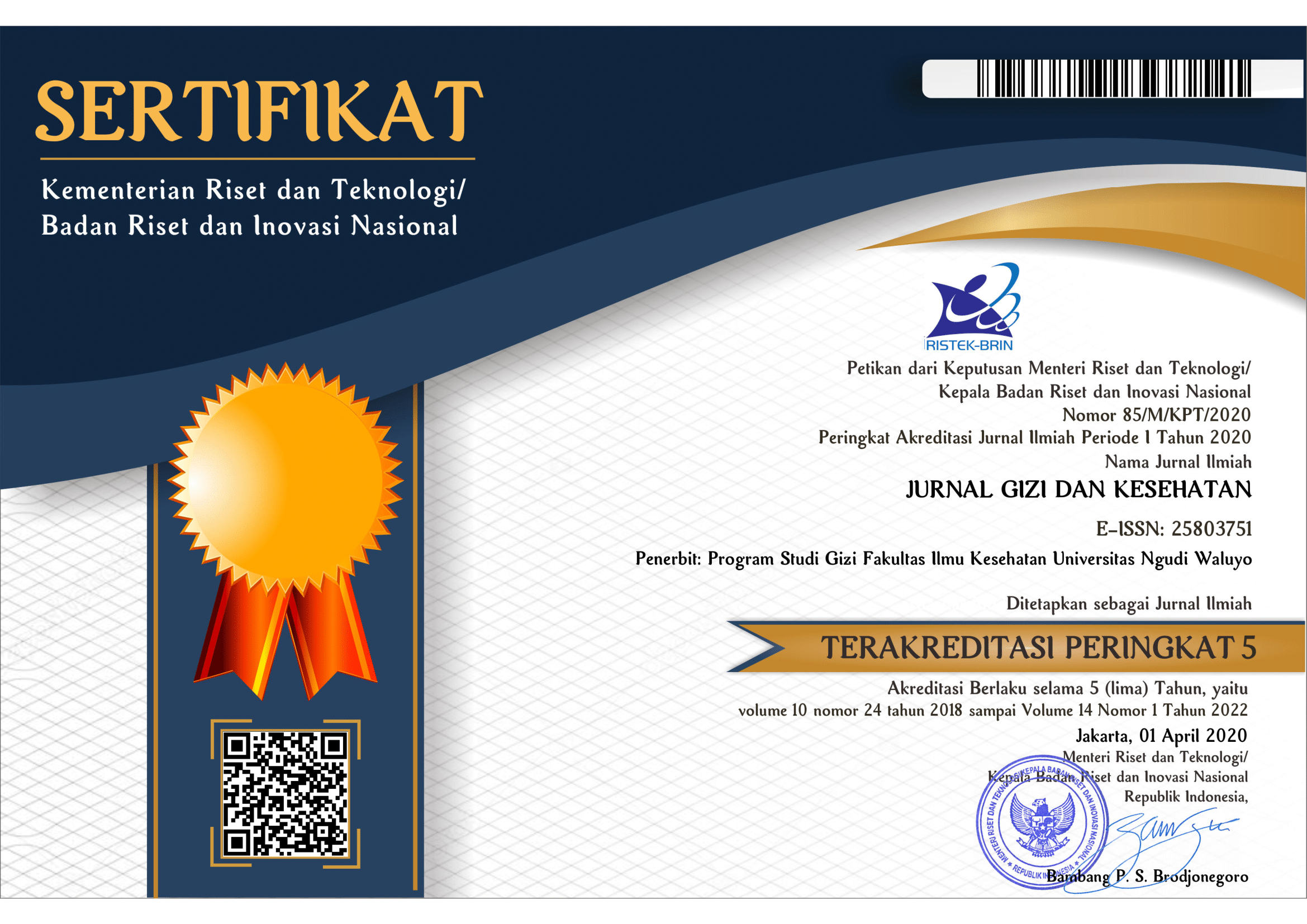HUBUNGAN ASUPAN ENERGI DAN ASUPAN LEMAK TERHADAP PROFIL LIPID PADA PENDERITA DISLIPIDEMIA
THE CORRELATION OF ENERGY INTAKE WITH FAT INTAKE ON LIPID PROFILE IN DISLIPIDEMIC PATIENTS
DOI:
https://doi.org/10.35473/jgk.v11i25.10Keywords:
Aupan Energi, Asupan Lemak, Profil Lipid, DislipidemiaAbstract
Background :High energy intake from saturated fat increases the risk of CHD especially in women. This abnormallipid profile is closely related to the development process atherosclerosis. Epidemiological, laboratory and clinical studies show an association of increased incidence of cardiovascular disease and other degenerative diseases with high cholesterol levels.
Method :The research design is cross-sectional. The subjects of the study were 30 employees of Kendal Hospital aged 35-50 years, suffering from dyslipidemia and not suffering from other metabolic or degenerative diseases based on the examination of a specialist in internal medicine. Examination of total cholesterol, LDL cholesterol were measured by vitros system chemistry analyzer 300 in the clinical pathology laboratory of Kendal Hospital. Food recall is done by using the food recall form through interviews conducted by trained and experienced nutritionists. Data analysis using Shapiro Wilk test and Spearman correlation test.
Results: The results of the data analysis were thatthere was a strong correlation between fat intake and total cholesterol levels (p = 0.01, r = 0.593), there was a correlation between energy intake withtotal cholesterol levels (p = 0.016, r = 0.434),there was an intake correlationfat with LDL levels (p = 0.011, r = 0.456) and there was no correlation between energy intake and LDL levels (p = 0.1119, r = 0.291),
Conclusion: There is a correlation between energy intake and total cholesterol (p = 0.016, r = 0.434), there is a strong correlation between fat intake and total cholesterol (p = 0.01, r = 0.593) and LDL (p = 0.011, r = 0.456).
Abstrak :
Latar Belakang : Asupan tinggi energi dari lemak jenuh meningkatkan risiko CHD khususnya pada wanita. Kelainan profil lipid ini erat hubungannya dengan proses perkembangan atherosklerosis. Penelitian epidemiologi, laboratorium dan klinik menunjukkan hubungan peningkatan kejadian penyakit kardiovaskular dan penyakit degeneratif lainnya dengan kadar kolesterol yang tinggi.
Metode : Rancangan Penelitian adalah crossecional. Subyek penelitian adalah 30 karyawati RSUD Kendal umur 35 – 50 tahun.Pemeriksaan kadar kolesterol total, kadar kolesterol LDL diukur dengan vitros system chemistry analyser 300 di laboratorium patologi klinik RSUD Kendal. Asupan gizi diukur dengan metode food recall 24 dihitung dengan program Nutrisurvey. Analisis data menggunakan uji Shapiro Wilk dan uji korelasi Spearman.
Hasil dan Pembahasan : Hasil analisa data adalah ada hubungan asupan energi dengan kadar kolesterol total (p=0,016, r=0,434), ada hubungan kuat asupan lemak dengan kadar kolesterol total (p=0,01, r=0,593), ada hubungan asupan lemak dengan kadar LDL (p=0,011, r=0,456) dan tidak ada hubungan asupan energi dengan kadar LDL (p=0,1119, r=0,291), Asupan tinggi energi mengakibatkan penimbunan lemak terutama trigliserida. Hal ini akan meningkatkan VLDL dan IDL darah yang akan berujung dengan peningkatan kolesterol total. Semakin tinggi seseorang mengkonsumsi makanan berlemak, maka timbunan kadar lemak dan trigliserida di dalam tubuh akan meningkat. Hal ini akan meningkatkan VLDL dan IDL darah.
Simpulan : Ada hubungan asupan energi dengan kadar kolesterol total (p=0,016, r=0,434), ada hubungan kuat asupan lemak dengan kadar kolesterol total (p=0,01, r=0,593) dan kadar LDL (p=0,011, r=0,456).
Downloads
References
Perkumpulan Endorinologi Indonesia (PERKENI) Petunjuk Praktis Penatalaksanaan Dislipidemia. 2008. 1-30.
Kahn, HS. The Lipid Accumulation Product Ferforms Better than the Body Mass Index for Recognizing Cardiovascular Risk : A Population Based Comparation, BMC Cardiovascular Disorders. 2006.
Fernandes RA et al.Prevalence of Dyslipidemia in Individuals Physically Active during Childhood, Adolescence and Adult Age. Arq Bras Cardiol 2011;97(4):317-323
Nelms M et al. 2010. Nutrition Therapy and Pathophysiology Second Edition
Aru W Sudoyo dkk. Buku Ajar Ilmu Penyakit Dalam Jilid III Edisi IV. Pusat Penerbit Departemen Ilmu Penyakit Dalam FKUI 2006; 1948 – 1953.
Bahri Anwar, T. Dislipidemia Sebagai Faktor Resiko Penyakit Jantung Koroner. Fakultas Kedokteran Universetas Sumatera Utara 2008.
Purwaningsih Endang dan Sugiri. Gizi dan Kesehatan Jantung. Harapan Baru Pencegahan dan Pengololaan Penyakit Jantung Iskemik. Badan Penerbitan Universitas Diponegoro Semarang 2008.
Perkumpulan Endokrinologi Indonesia (PERKENI). Petunjuk Praktis Pengelolaan Diabetus Melitus. 2002.
Murray R K et al. Biokimia Harper. EGC. Jakarta edisi 27. 2009;15:128- 138; 25:225-249
Stump SE. Nutrition and Diagnosis- Related Care. 2008; 7th ed: 307-357
Gropper SS dan Smith JL. Advanced Nutritrion and Human Metabolism 5th ed. Belmont (CA) : Wadsworth Cengage Leaning ; 2009
Eckel RH et al. Understanding the Complexity of Trans Fatty Acid Reduction in the American Diet: American Heart Association Trans Fat Conference 2006: Report of the Trans Fat Conference Planning Group. Circulation. 2007;115:2231–46.
Oluwabunmi A Tokedeet al. Plasma phospholipid trans fatty acids and risk of heart failure1,2,3. 2013 American Society for Nutrition. Didownload dari www.ajcn.org pada tanggal 28 Agustus 2013.
Mozaffarian D et al. Dietary Intake of Trans Fatty Acids and Systemic Inflammation in Women. Am J Clin Nutr. 2004;79:606–12.
Rodenas S et al. Dietary Exchange of an Olive Oil and Sunflower Oil Blend for Extra Virgin Olive Oil Decreases the Estimate Cardiovascular Risk and LDL and Apolipoprotein AII Concentrations in Postmenopausal Women. J Am Coll Nutr. 2005;24:361–69.
Trichopoulou A. Costacou T, Bamia C, Trichopoulos D. Adherence toa Mediterranean diet and survival in a Greek population. New England Journalof Medicine. 2003;348:2599– 2608.
Pereira MA et al. Dietary Fiber and Risk of Coronary Heart Disease: a Pooled Analysis of Cohort Studies. Arch Intern Med. 2004;164: 370–76.
Anne Le Kim et al. Fructose Overconsumption Causes Dyslipidemia and Ectopic Lipid Deposition in Healthy Subjects with and without a Family History of type 2 Diabetes1–4 .Am J Clin Nutr 2009;89:1760–5. Downloaded from ajcn.nutrition.org by guest on August 28, 2013
Krauss RM et al. Separate Effects of Reduced Carbohydrate Intake and Weight Loss Onatherogenic Dyslipidemia1–3. Am J Clin Nutr 2006;83:1025–31. Downloaded from ajcn.nutrition.org by guest on August 28, 2013
Hansen et al.Effect of Red Wine and Red Grape Extract on Blood Lipids, Haemostatic Factor and Other Risk Factors for Cardiovascular Disease. Eur J Clin Nutr. 2005;55:449
Lairon et al.Dietary Fiber Intake and Risk Factors for Cardiovascular Disease in French Adults. Am J Clin Nutr. 2005;82:1185 Slavin JL. Dietary Fiber and Body weight. Nutrition. 2005;21:411–18
Oguma dan Shinoda-Tagawa. Physical Activity Decreases Cardiovascular Disease Risk in Women : Review and Meta-Analysis. Am J Prev Med. 2004;26:407
Granjean PW et al. Infuence of Cholesterol on Blood Lipid and Lipoprotein Enzyme Resposes to Aerobic Exercise. J. Appl Physiol 2000; 89 : 472 – 480
Ebbert Jon O and Jensen Michael D. Review : Fat Depots, Free Fatty Acids, and Dyslipidemia. Nutrients 2013, 5, 498-508.
Delmi Sulastri, Sri Rahayuningsih, Purwantyastuti. Pola Asupan Lemak, Serat, dan Antioksidan, serta Hubungannya dengan Profil Lipid pada Laki-laki Etnik Minangkabau. Majalah Kedokteran Indonesia, 2005; Volum: 55, Nomor: 2
Poirier P et al. 2006. Obesity and cardiovascular disease: Pathophysiology, Evaluation and Effect of Weight Loss. Circ.2006;113:898–918
Sugiri. Peran Penataan Gaya Hidup dalaam Pencegahan Serangan Jantung. Fakultas Kedokteran UNDIP, Semarang. 2008
Ambrose JA, Barua RS. The Pathophysiology of Cigarette Smoking and Cardiovascular Disease. J Am Coll Cardiol 2004;43:1731–37
American Heart Association. Heart Disease and Stroke Statistics_2009 Update: A Report From the American Heart Association Statistics Committee and Stroke Statistics Subcommittee. Circulation 2009;119:e21–e181
Barnard DD. Heart Failure in Women. Curr Cardiol Rep. 2005;7:159–65
Husaini, M.A. Gizi, Proses Penuaan dan Umur Panjang. Pusat Penelitian dan Pengembangan Gizi, Departemen Kesehatan RI, Bogor. 2001. 2001
Soeharto. Serangan Jantung dan Stroke Hubungannya dengan Lemak dan Kolesterol Edisi kedua. Gramedia Pusat.2004
Marit EJ et al. Lifestyle Modifies Obesity-Assosiated Risk of Cardiovascular Disease in A Genetically Homogeneous Population. Am J Clin Nutr 2006;84:29-36
Andrew S Greenberg and Martin S Obin. Obesity and Role Adipose Tissue in Metabolism. Am J Clin Nutr 2006;83(suppl):461S-5S.










